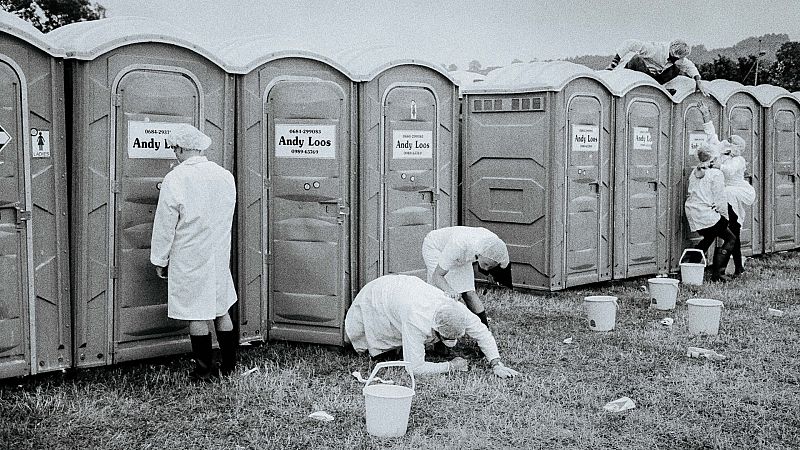
PHOTOGRAPHER LIAM BAILEY ON CAPTURING 30 YEARS OF GLASTONBURY FESTIVAL'S ANARCHIC ATMOSPHERE
Liam Bailey came to both photography and music festivals later in life. After stints in odd jobs, the British photographer found his passion while attempting to teach football to American school children.
Uninterested in learning soccer (as they called it), the Chicago school noticed his chemistry degree and handed him the keys to a camera development studio. There, Bailey learned the tools of his future trade.
After moving back to the UK, it was a chance gig with a charity that handed him his first Glastonbury press ticket in 1992, aged 27. The festival had already grown to be a legendary part of the British music scene since its founding in 1970, but Bailey went in somewhat unaware.
“I walked out and went down the hill and Manic Street Preachers were playing ‘Motorcycle Emptiness’. I thought it was coming from a speaker,” Bailey tells Euronews Culture. “I’d never heard live music before.”
The moment had a profound effect on Bailey. “It stuck with me from then. It was immediate,” he says. “It’s been like that ever since. I’ve always treated it like a job. Like it’s my responsibility to capture this festival for myself and now for others.”
Bailey hasn’t missed an edition of the festival since then. He’s always there. He travels alone and takes pictures of the crowds, the community, and the spirit of Glastonbury. After over 30 years making this annual pilgrimage, he’s finally collated 86 of his images into a striking visual memoir of the festival.
"Glastonbury: The Festival and Its People" has been released by ACC Art Books just in time for the 2024 edition. It brings together Bailey’s years of documenting the festival, first in black-and-white on his Leica film camera, and his more recent digital colour shots.
For many fans of the UK’s biggest music festival, the draw is the myriad music acts organisers Michael and Emily Eavis book every year. In our conversation, Bailey chats fondly of seeing stars like Oasis, Blur and Pulp in the 90s, Radiohead performing ‘OK Computer’ and Bowie’s legendary 2000 set. But a casual glance through his images and it’s clear that Bailey’s focus is always looking back into the crowds.
Over 200,000 people attend Glastonbury every year. When it’s on, the festival is the seventh biggest city in the south of England, just behind Brighton population-wise. Since its founding, Glastonbury has always been more than just a glorified music venue, with a manifesto that included the environmental and spiritual ethos that is at the core of the annual tradition.
When Bailey first attended in the 90s, Britain was ruled by the right, still under Thatcherism’s spell. Glastonbury felt like a place for the “outliers” of that society then. “We were the people who, to the public eye, were wastrels and weren’t contributing to society. But I was watching these people work from a different perspective.”
Bailey saw people in the community, “supporting each other, helping build and achieve great things.” “I suddenly became very excited about that side of the festival,” he recalls.
The book’s images capture the rugged anarchy that spreads through Somerset each year around the solstice. In one, a grainy monochrome still probably from his early days, two men play acoustic guitars in front of a campervan where a child looks on curiously.
Glastonbury’s values as a place for like-minded music lovers to find community and family outside of normal society and Bailey’s gift for telling the stories of the festival’s attendees in a single image combine perfectly. This “non-chaotic ordered anarchy allows Britain to have a sort of release valve for humans to do these sorts of things.”
“Now we understand we have to support each other. We’ve got to support the environment. It’s not all about work. It’s not all about money. It’s more about wellness and a sense of balance, and being a part of something instead of trying to exploit it,” Bailey says.
Even as the festival gets more expensive – tickets went for £360 (€425) this year – and more camping ground is given to luxury glamping experiences, Glastonbury has no VIP packages on offer. There are no segregated viewing platforms for higher earners. All attendees are treated equally. True to its values, much of the large influx of money from the glamping areas is donated straight to charities like Greenpeace and Oxfam.
Some have bemoaned that the festival is becoming a middle-class stomping ground in recent years, but Bailey stays optimistic. “Everyone who goes there for the first time gets the same experience and feelings as the first time we did,” he says.
Whether you’re a normal ticket holder or one of the 75,000 artists, performers, organisers, and other festival workers like Bailey, everyone is involved in the act of creation at Glastonbury, he says. “We all have to do something to be at Glastonbury.”
When Bailey first attended the festival, cameras were scant. These days, everyone records Glastonbury from their smartphones, and teams of journalists snap pictures across the site.
While Bailey is technically included in the pool of press photographers invited every year, he recognises he’s not a traditional one. He’s rarely been commissioned to work and has only occasionally had his work shown after the fact. That Glastonbury invites him back year-on-year is testament to the festival’s embrace of artists making art for art’s sake.
Over 30 years since he first attended, Bailey’s book ‘Glastonbury: The Festival and Its People’ finally brings his decades of experiencing the festival into a beautiful single concise volume. “I do feel as though they’ve quietly allowed me to walk alongside it [the festival]” Bailey says. “I think they expected, at some point, I'd probably have to burst out and do something with the work.”
Glastonbury 2024 takes place from 26 - 30 June.
2024-06-23T08:14:16Z dg43tfdfdgfd